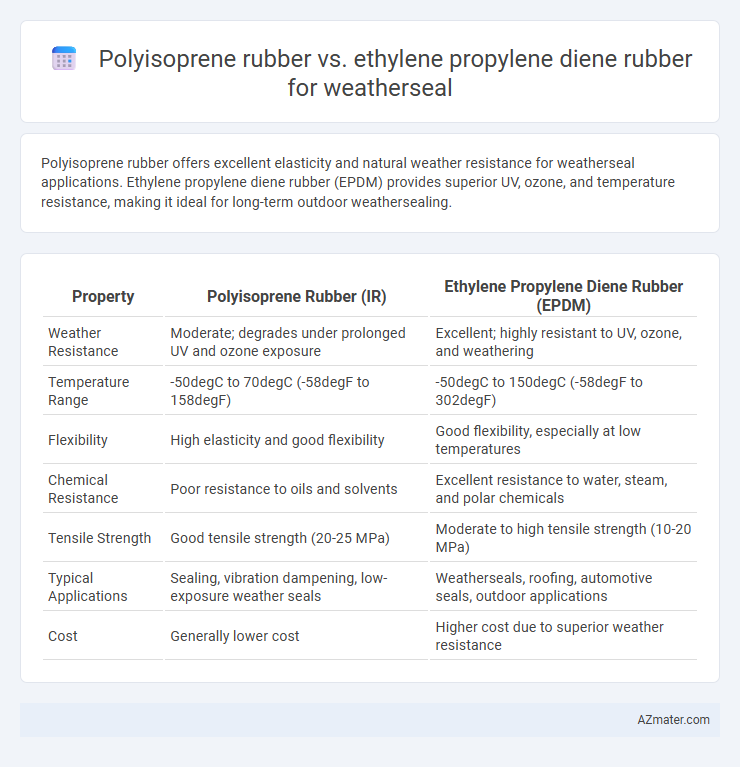Polyisoprene rubber offers excellent elasticity and natural weather resistance for weatherseal applications. Ethylene propylene diene rubber (EPDM) provides superior UV, ozone, and temperature resistance, making it ideal for long-term outdoor weathersealing.
Table of Comparison
| Property | Polyisoprene Rubber (IR) | Ethylene Propylene Diene Rubber (EPDM) |
|---|---|---|
| Weather Resistance | Moderate; degrades under prolonged UV and ozone exposure | Excellent; highly resistant to UV, ozone, and weathering |
| Temperature Range | -50degC to 70degC (-58degF to 158degF) | -50degC to 150degC (-58degF to 302degF) |
| Flexibility | High elasticity and good flexibility | Good flexibility, especially at low temperatures |
| Chemical Resistance | Poor resistance to oils and solvents | Excellent resistance to water, steam, and polar chemicals |
| Tensile Strength | Good tensile strength (20-25 MPa) | Moderate to high tensile strength (10-20 MPa) |
| Typical Applications | Sealing, vibration dampening, low-exposure weather seals | Weatherseals, roofing, automotive seals, outdoor applications |
| Cost | Generally lower cost | Higher cost due to superior weather resistance |
Introduction to Weatherseal Materials
Polyisoprene rubber offers high elasticity and excellent tensile strength, making it a reliable choice for weatherseal applications requiring flexibility and durability. Ethylene propylene diene rubber (EPDM) stands out for superior resistance to weathering, ozone, UV exposure, and temperature extremes, which enhances the lifespan of exterior seals. Both materials provide effective sealing solutions, with EPDM preferred for harsh outdoor environments and polyisoprene favored for applications needing natural rubber properties.
Overview of Polyisoprene Rubber
Polyisoprene rubber, a synthetic elastomer closely resembling natural rubber, offers excellent elasticity, tensile strength, and wear resistance, making it ideal for weatherseal applications where flexibility and durability are crucial. Its low compression set and resistance to abrasion help maintain effective sealing in dynamic environments exposed to varying temperatures and mechanical stress. Compared to Ethylene Propylene Diene Monomer (EPDM) rubber, polyisoprene provides superior resilience but has limited resistance to ozone, UV light, and certain chemicals, which can affect long-term weathering performance.
Overview of Ethylene Propylene Diene Rubber (EPDM)
Ethylene Propylene Diene Rubber (EPDM) is a synthetic elastomer known for its exceptional resistance to weathering, ozone, UV radiation, and extreme temperatures, making it ideal for weatherseal applications. Unlike polyisoprene rubber, EPDM offers superior durability and maintains flexibility over a wide temperature range from -40degC to 150degC, ensuring long-lasting performance in harsh outdoor environments. Its chemical resistance to water, steam, and polar substances enhances the reliability and lifespan of seals in automotive, construction, and industrial sealing systems.
Weather Resistance: Polyisoprene vs. EPDM
Polyisoprene rubber offers moderate weather resistance but is prone to degradation under prolonged UV exposure and ozone attack, limiting its durability in outdoor weatherseal applications. Ethylene propylene diene monomer (EPDM) excels in weather resistance due to its superior ozone, UV, heat, and moisture stability, making it the preferred choice for long-lasting weatherseals. EPDM's molecular structure provides enhanced elasticity retention and resilience in extreme weather conditions compared to polyisoprene.
Flexibility and Elasticity Comparison
Polyisoprene rubber exhibits superior flexibility and elasticity compared to Ethylene Propylene Diene Monomer (EPDM) rubber, making it ideal for weatherseals requiring high stretchability and recovery. EPDM rubber offers excellent resistance to weathering, ozone, and UV exposure but has lower elongation at break and elastic recovery than polyisoprene. Therefore, polyisoprene is preferred in applications prioritizing dynamic flexibility, while EPDM excels in long-term durability under harsh environmental conditions.
UV and Ozone Resistance
Polyisoprene rubber offers moderate UV resistance but degrades faster under prolonged ozone exposure, making it less suitable for weatherseal applications in harsh outdoor conditions. Ethylene propylene diene monomer (EPDM) rubber exhibits superior UV and ozone resistance due to its saturated polymer backbone and ethylene-propylene-diene structure, providing enhanced durability and longevity in weatherseals. EPDM's excellent resistance to environmental stress cracking and ozone-induced deterioration makes it the preferred choice for outdoor sealing systems exposed to sunlight and ozone-rich atmospheres.
Longevity and Durability in Outdoor Applications
Polyisoprene rubber offers excellent elasticity and resilience but is less resistant to UV radiation, ozone, and weathering compared to Ethylene Propylene Diene Monomer (EPDM) rubber, making EPDM the preferred choice for outdoor weatherseal applications. EPDM exhibits superior longevity and durability due to its high resistance to heat, oxidation, and environmental stress cracking, ensuring extended lifespan in harsh outdoor conditions. The enhanced weather resistance of EPDM reduces maintenance needs and replacement frequency in weatherseals exposed to sun, rain, and temperature fluctuations.
Cost and Availability Considerations
Polyisoprene rubber offers a cost-effective solution with excellent elasticity, making it suitable for weatherseal applications where affordability and moderate performance suffice. Ethylene propylene diene rubber (EPDM) typically carries a higher price but provides superior weather, ozone, and UV resistance, extending the lifespan of weatherseals in harsh environments. Availability of polyisoprene is widespread due to its natural rubber origins, while EPDM's synthetic production ensures consistent supply but may incur fluctuating costs tied to petrochemical market trends.
Suitability for Automotive and Construction Weatherseals
Polyisoprene rubber offers excellent flexibility and resilience, making it suitable for automotive weatherseals that require tight sealing under varying temperatures and dynamic movement. Ethylene propylene diene rubber (EPDM) excels in resistance to UV radiation, ozone, and extreme weather conditions, which are critical for durable construction weatherseals exposed to prolonged outdoor environments. EPDM's superior aging performance and chemical resistance position it as the preferred choice for long-term sealing applications in both automotive and construction sectors.
Conclusion: Selecting the Best Rubber for Weatherseals
Polyisoprene rubber offers excellent elasticity and resilience, making it ideal for weatherseals requiring superior flexibility and abrasion resistance. Ethylene propylene diene rubber (EPDM) excels in ozone, UV, and chemical resistance, ensuring long-lasting performance in harsh environmental conditions. Selecting the best rubber for weatherseals depends on prioritizing flexibility and wear versus environmental durability, with EPDM favored for outdoor exposure and polyisoprene preferred for dynamic sealing applications.

Infographic: Polyisoprene rubber vs Ethylene propylene diene rubber for Weatherseal
 azmater.com
azmater.com